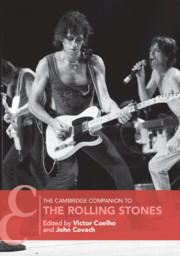Book contents
- The Cambridge Companion to the Rolling Stones
- Cambridge Companions to Music
- The Cambridge Companion to the Rolling Stones
- Copyright page
- Dedication
- Contents
- Illustrations
- Tables
- Notes on Contributors
- Preface
- Abbreviations
- Part I Albums, Songs, Players, and the Core Repertory of the Rolling Stones
- 1 The Rolling Stones: Albums and Singles, 1963–1974
- 2 Guitar Slingers and Hired Guns: The Musicians of the Rolling Stones
- 3 The Rolling Stones in 1968: In Defense of Lingering Psychedelia
- 4 Exile, America, and the Theater of the Rolling Stones, 1968–1972
- 5 Post Exile: The Rolling Stones in a Disco-Punk World, 1975–1983
- Part II Sound, Roots, and Brian Jones
- Part III Stones on Film, Revival, and Fans
- Bibliography
- Index of Songs, Albums, and Visual Media Cited in the Text
- General Index
5 - Post Exile: The Rolling Stones in a Disco-Punk World, 1975–1983
from Part I - Albums, Songs, Players, and the Core Repertory of the Rolling Stones
Published online by Cambridge University Press: 23 August 2019
- The Cambridge Companion to the Rolling Stones
- Cambridge Companions to Music
- The Cambridge Companion to the Rolling Stones
- Copyright page
- Dedication
- Contents
- Illustrations
- Tables
- Notes on Contributors
- Preface
- Abbreviations
- Part I Albums, Songs, Players, and the Core Repertory of the Rolling Stones
- 1 The Rolling Stones: Albums and Singles, 1963–1974
- 2 Guitar Slingers and Hired Guns: The Musicians of the Rolling Stones
- 3 The Rolling Stones in 1968: In Defense of Lingering Psychedelia
- 4 Exile, America, and the Theater of the Rolling Stones, 1968–1972
- 5 Post Exile: The Rolling Stones in a Disco-Punk World, 1975–1983
- Part II Sound, Roots, and Brian Jones
- Part III Stones on Film, Revival, and Fans
- Bibliography
- Index of Songs, Albums, and Visual Media Cited in the Text
- General Index
Summary
How, in the 1970s, did a generation whose motto was “never trust anyone over thirty” come to grips with an iconic 1960s rock band whose members were entering their mid-thirties? On the whole, not very well. Mick Jagger, in an unguarded moment, wistfully observed: “I’m afraid rock and roll has no future … It’s only recycled past.”1 The mid-1970s was a time of considerable turmoil and transition for the Stones, and for rock music in general.2 The music industry was still sorting itself out after the breakup of the Beatles at the very beginning of the 1970s. Historically, the spread of the bucolic culture envisioned by Woodstock already seemed in rot. The 1970s were riven with crises – Vietnam, Watergate, labor strife in Britain, the Troubles in Northern Ireland, global concerns about pollution and overpopulation, the energy crisis, planned obsolescence, the Munich Olympic massacre, the Biafran War, the India-Pakistan War, and the Yom Kippur War, are only a few of the most important calamities that mark the decade. Amidst this turbulence – often simplistically chronicled in rock history by contrasting the Stones’ dystopian concert at Altamont with the utopian ideals of Woodstock – the Rolling Stones faced a novel predicament: how to remain at the forefront of rock while entering a stage of life more traditionally associated with conventional adulthood.
- Type
- Chapter
- Information
- The Cambridge Companion to the Rolling Stones , pp. 75 - 98Publisher: Cambridge University PressPrint publication year: 2019

